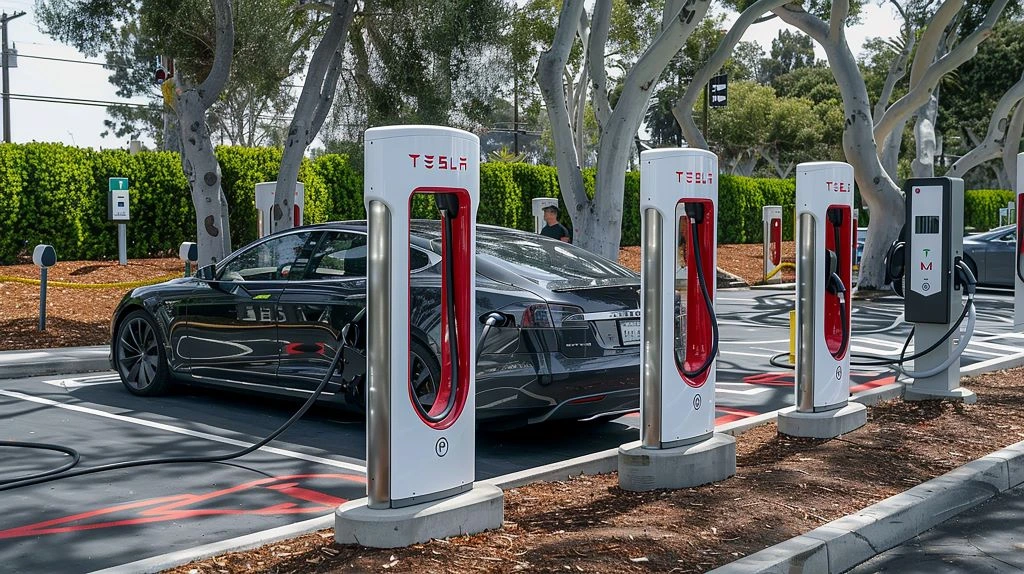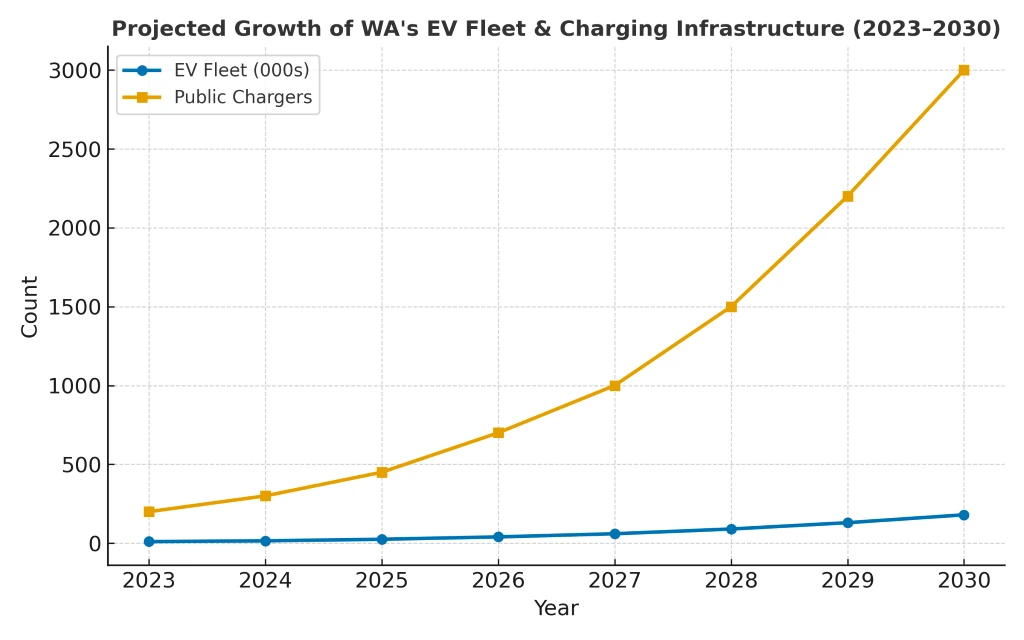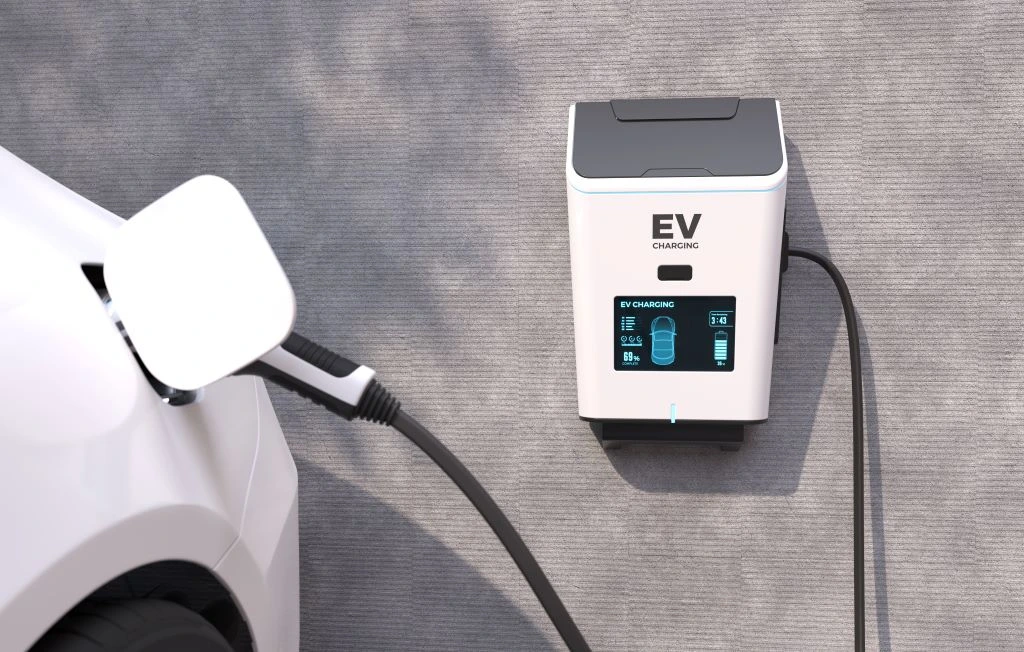Electric vehicles are becoming a familiar sight in Albany, and with them comes the need for a reliable charging network. EV charging infrastructure in Albany refers to the growing system of public and private charging stations that keep electric cars on the move. It’s not just a convenience—it’s part of a wider shift towards cleaner transport, lower running costs, and meeting Australia’s climate goals. In this article, we’ll break down what EV charging infrastructure looks like locally, how much it costs to use or install, the benefits it brings, and what the future holds for drivers in the region.
Albany’s charging network has expanded significantly in recent years, supported by state programs, local council initiatives, and private investment. From slower AC chargers at shopping centres to high-speed DC stations on major routes, the city now offers options for both everyday commuting and long-distance travel. Understanding how these systems work, their costs, and the advantages they offer will help residents and visitors make the most of Albany’s electric vehicle infrastructure.
Understanding EV Charging Infrastructure in Albany
When we talk about EV charging infrastructure in Albany, we mean all the places and equipment that let EVs recharge. It’s like the city’s gas stations – but for electrons, not petrol. There are three common types:
- Level 1 (Slow) Chargers: These are just a normal 240V power outlet (or the car’s portable charger) that you might use at home. It adds a few kilometres of range per hour, so you typically plug in overnight for a full charge.
- Level 2 (Fast AC) Chargers: These are wall-boxes (7–22 kW) you find in homes, public carparks, malls and hotels. They’re much faster than a standard outlet – think: recharge while you shop. A flat battery to ~80% usually takes 4–8 hours.
- Level 3 (DC Fast Chargers): These are the real road-trip heroes (50–350 kW units) often called “Rapid” or “Ultra-Fast” chargers. At Albany’s new Synergy stations, for example, a 150 kW DC charger can add significant range in about 30 minutes. These are installed along highways and travel routes so you can top up quickly on long drives.
Pictured: A Tesla Supercharger station in WA (Eaton).

Stations like this serve the EV charging network across Western Australia, offering high-speed DC power to two vehicles at once. EV charging infrastructure includes these rapid plugs as well as slower AC chargers around town.
Each charger type has its place. Level 2 chargers are perfect for daily use – you might plug in at home or at the office. Level 3 (DC) chargers are for when you’re on the go and need a quick fill-up, such as at Albany’s tourist sites or highway stops. As we’ll see, Albany’s charging network now includes both kinds, thanks to state programs and local efforts.
The Current State of EV Charging Infrastructure in Albany
Albany’s charging network is growing. As of mid-2023, the city boasts 16 public charging locations across the region. These span the municipality – from Cheynes (east) to the Albany Visitor Centre and even to Mount Romance (north) – ensuring most travellers can find a plug. The City of Albany (with support from the WA Government and companies like Synergy) has installed new high-speed chargers at key spots. For example, two 150 kW DC fast-chargers were added at the Old Gaol carpark in 2023. These can recharge an EV to ~80% in as little as half an hour, letting drivers “top up” quickly between destinations.
An Albany DC fast-charger installed in 2023 (Old Gaol parking area) – part of WA’s state EV network. Each unit can service two cars at once and supports credit card or RFID payment. Albany’s public chargers now include shopping-centre outlets, hotel chargers, and these new ultra-fast stations, giving drivers plenty of options.
Albany’s charging stations come from different providers. Synergy (the state energy company) runs the WA EV Network, which delivers many of the new fast chargers. This network is part of a broader rollout that now spans 110 charging points across 49 locations across WA, forming one of the longest connected EV “highways” in the world (WA Government media release). Chargefox and EVUp operate others (for example, several EVUp AC chargers are at local hotels), and private networks (like Tesla’s own Supercharger network) may have their own locations nearby. This mix means you as a driver usually find a compatible charger, whether you need a slow 7 kW AC plug or a fast DC pump. In Western Australia, the goal is to have chargers spaced fairly evenly (often less than 200 km apart) so that range anxiety vanishes.
Below is a quick reference of typical charger types in Albany, their costs and locations (all figures approximate):
| Charger Type | Avg. Cost (A$/kWh) | Time to Charge 0–80% | Common Albany Locations |
|---|---|---|---|
| Level 2 (AC, 7–22 kW) | A$0.20–0.35 (public rate) | ~4–8 hours | Malls, hotels, visitor centre, city car parks |
| DC Fast (100–150 kW) | A$0.40–0.60 (public rate) | ~30–60 mins | Highways (e.g. Albany Old Gaol), EV hubs |
(Sources: WA charging providers, local network data.)
So if you’re out shopping or staying overnight, a Level 2 charger (often free or cheap) might top you up slowly. For road trips, Albany’s DC stations let you re-juice rapidly. The key is that Albany’s EV charging infrastructure now covers both daily urban use and long-distance travel.
Costs of EV Charging Infrastructure
For Drivers: Installing a home charger is the first cost most people face. A basic Level 2 home wallbox (7–11 kW) hardware typically costs on the order of A$1,000–$2,500, plus an electrician’s fee (often a few hundred dollars). This lets you plug in at home overnight – much cheaper than a daily petrol run. Off-peak electricity in WA can be around 20–25 c/kWh, so a 15 kWh charge (about 100 km of range) might cost only $3–$4 overnight.
Public charging is pricier. As a rule, slower AC chargers cost less per kWh than fast DC. For example, Chargefox’s 22 kW AC costs around A$0.20–0.30/kWh, whereas their 50–150 kW DC costs A$0.40–0.60/kWh. Tesla Superchargers charge about A$0.63/kWh in WA. (Some spots – like certain mall chargers – are free or included with parking.) In Albany, the two new Synergy fast chargers accept credit card or RFID payments, so expect to pay per kWh (roughly 50c–60c, similar to other DC stations).
For Businesses/Government: Setting up charging stations can range from a few thousand to tens of thousands of dollars. A home/community Level 2 station hardware is ~$2k–3k. By contrast, installing a public 150 kW DC station is very expensive – on the order of A$40,000–$100,000 for the unit alone (plus hefty installation work). According to EV installers, a curbside or carpark DC charger can easily hit six figures once trenches and electrical upgrades are included.
Thankfully, the WA government has sweetened the deal. Grants under the “Charge Up” program co-fund up to 50% of EV charger installs for local councils, businesses and community groups. In other words, Albany businesses could get half the hardware/installation costs covered. Plus, clever planning can reduce bills: by charging during the daytime (when solar power is abundant), everyone saves money and avoids grid strain.
Benefits of EV Charging Infrastructure in Albany
Electric cars aren’t just cool toys; their charging network delivers real benefits to Albany’s people and planet.
- Environmental: EVs emit no tailpipe fumes, so each plug-in means cleaner air and lower carbon. The Electric Vehicle Council notes that even on today’s grid, EVs have lower lifetime emissions than petrol cars. In the Albany area (and the wider Great Southern), this means we breathe fewer pollutants from diesel generators and old petrol vehicles. Over time, as WA’s grid adds more solar and wind, EV charging will be driven mostly by green energy, making our cars even cleaner.
- Economic: Charging an EV costs far less per kilometre than buying petrol. By rough estimates, driving 100 km in an EV might cost $5–$8 in electricity, versus $20+ in fuel. That’s real savings for Albany drivers. And it’s not just drivers who win – local businesses do too. One witty WA travel story even coined the mantra “Always Buy Cake” – meaning: instead of spending cash on fuel imported from overseas, EV drivers can spend it at Albany cafes, shops and landmarks. More chargers bring in more EV tourists who stop for coffee or a pie while waiting for their car.
- Social: As an EV owner myself, I’ve noticed that charging times can turn into community time. You chat with fellow drivers, share tips (“PlugShare always shows when a charger’s free!”). The charging infrastructure also makes Albany more attractive to cutting-edge residents and visitors. Imagine a tech-savvy professional deciding whether to move here – knowing Albany is EV-friendly (with chargers at their favorite shopping center or park) can tip the scale.
- Resilience: More local charging points means less dependence on unpredictable fuel prices. Electricity (especially solar) provides a stable, local source of “fuel.” Plus, clever features like vehicle-to-grid (V2G) or solar-integrated chargers on the horizon could help stabilize the grid, though that’s just getting started.
Local Anecdote: I recall chatting with a friend who lives in Albany and drives electric. He jokes that his only “road trip anxiety” now is finding the best cafe while his EV charges (charging time = coffee time). Last week he saved nearly $40 on a 300 km trip by using chargers instead of petrol – money he happily plowed into local businesses. Stories like his show why community benefits flow from EV infrastructure.
The Future of EV Charging in Albany
Buckle up: EVs are accelerating into Albany’s future. Statewide targets and technology trends mean EV charging infrastructure in Albany will only get bigger and better.
By 2030, Western Australia’s EV adoption is expected to reach about 10% of new cars. To support that, experts estimate we’ll need over 4,000 fast chargers statewide. In practical terms, that means more stations on Albany’s corridors and inner suburbs. Already, the WA Government’s $21 million EV Network plan is rolling out 98 chargers at 49 sites across the state – a blueprint that includes places like Albany. In fact, Synergy says its WA EV Network will span 7,000 km from border to border, ensuring towns like Albany aren’t left behind.
Technology will also level up. We can expect ultra-fast 350 kW chargers (able to add 200 km of range in ~10 minutes) at key stops. Solar-powered charger bays (with rooftop panels and battery storage) are on trial in some places, meaning your car could be topped up with free sunshine. And one day, your EV might even send power back to the grid at home (vehicle-to-grid, or V2G) during peak hours, helping balance the network. The synergy between charging and clean energy is growing: for instance, Synergy’s future-plan talks up V2G and integration with rooftop solar.
On the policy side, Albany will benefit from ongoing support. The Western Australian government has set clear EV strategy goals (net-zero carbon by 2050, etc.) and offers grants like Charge Up to fund more chargers. Local Council is also keen – as Mayor says, Albany wants to reduce its footprint while making life easier for drivers.

The message? More EVs = more infrastructure. And for you as a driver, that means planning will get simpler. Soon, apps and car nav-systems will automatically route you through Albany via the fastest chargers (no one likes detours!).
Tips for Using EV Charging Infrastructure Efficiently
To make the most of Albany’s chargers (and be a courteous EV citizen), keep these tips in mind:
- Plan with Apps: Use free tools like PlugShare or Chargefox. These apps show nearby EV charging stations, their availability, and even “check-in” statuses. For example, PlugShare’s trip-planning feature maps out stations along your route. I always check ahead: if one charger is broken or busy, the app finds the next.
- Respect Charging Etiquette: Charging bays aren’t parking spots! Only plug in if you’re actively charging. As the Australian Electric Vehicle Assoc. advises: “Never park in a charging bay if you are not charging… Move your car as soon as it’s done.”. Likewise, if there are multiple chargers, choose one that fits your needs (fast vs. slow) so you don’t slow others. Pro tip: If you’re at a DC fast charger and your battery is at ~80%, it slows down – so if someone’s waiting, consider pulling over after 80%.
- Charge at Smart Times: Whenever possible, charge during the day or off-peak. Why? WA’s government points out that daytime charging uses your home solar (if you have it) and cheaper tariffs. Even without solar, many tariffs are lowest at night or midday now. A smart charger (or just a timer) can automatically start charging when rates drop.
- Stay Tidy and Safe: Always reel in the cable and leave the charger neat. Don’t leave rubbish by the unit. If charging at a hotel or B&B overnight, be a good guest: ask if they need a fee, and never overload their circuits. The EV Association suggests sharing info – even list the charger on PlugShare – so future EV visitors know it’s there.
- Carry Cables & Cards: Not all public chargers supply a cable. Always keep your own Type 2 cable (the common Australian plug) in your trunk. And consider signing up for a charging network’s app or RFID card (e.g. Chargefox) – it saves time at stations that require an account.
- Mind Your Battery: To maximize battery life, try to keep it between 20–80% for daily charging. You don’t need to reach 100% every time (and it slows down a lot near 100%). Instead, do smaller charges often. Most EVs let you set a charging limit – use it. (This also means you’ll finish charging faster and free up the spot sooner.)
By following these pointers, you help everyone get around more smoothly. Charging stations are valuable shared resources – a little thought goes a long way.
FAQs
How many EV chargers are in Albany?
Albany currently has about 16 public charging locations. This includes Level 2 chargers at places like malls and hotels, plus DC fast chargers at strategic sites.
Is EV charging in Albany free?
Some local Level 2 chargers (for example, at shopping centres or community buildings) are offered free of charge. However, most public fast chargers charge by the kWh. Expect roughly A$0.40–$0.60 per kWh at DC fast stations (Level 2 rates are lower, around 20–30c/kWh).
Can I install a charger at home?
Yes. Home EV chargers (Level 2 wallboxes) are very common. The hardware typically costs around A$1,000–$2,500, and a licensed electrician can install it in a few hours. Once installed, you just plug in every night!
How long does EV charging take in Albany?
It varies. A DC fast charger can top up a battery to ~80% in 30–40 minutes. A Level 2 charger, by contrast, might take 4–8 hours for the same amount (suitable for overnight charging). In practice, if you’re parked for a quick errand, a fast charger fills in minutes; if you’re home or at work, the slower AC charger runs while you sleep or work.
Will EV charging infrastructure expand?
Absolutely. Western Australia’s EV plan calls for many more chargers statewide. Synergy’s WA EV Network is installing dozens of new stations (98 across 49 locations). In Albany, that means more spots on travel routes and in public carparks in the coming years. In short, you’ll see a lot more EV charging stations in Albany as EV adoption grows.
Conclusion
EV charging infrastructure in Albany is blossoming – and that’s good news for drivers and the planet. We’ve seen how Albany now has dozens of public chargers (16 locations and counting), and how costs stack up for drivers and hosts. The benefits are clear: cleaner air, cheaper trips, and a boost to the local economy as EV drivers stop to spend money in town. Looking forward, state plans and new tech promise an ever-expanding network of chargers every 200 km or less.
So whether you’re an EV veteran or just curious, it’s a great time to plug in. Explore Albany’s charging map (yes, that web app or PlugShare map) and see what’s already around you. Keep an eye on upcoming installations and grants – maybe your workplace or apartment block could get a charger soon. Who knows, the next time you drive into town, you might find a brand-new ultra-fast charger waiting to refill your batteries!
Call to Action: If you’re considering an EV, give it a try – rent one for a weekend trip, or talk to neighbours who own one. Follow WA’s official EV pages (like Synergy’s WA EV Network) to track new EV charging infrastructure rollouts in Albany. Charge up, drive green, and maybe even score that midnight snack during your next recharge – the future of driving in Albany is electric.

